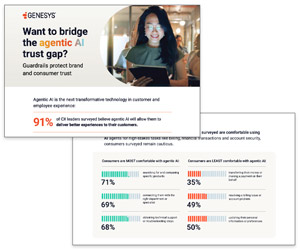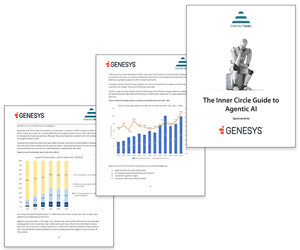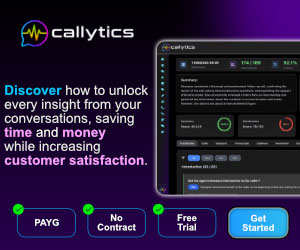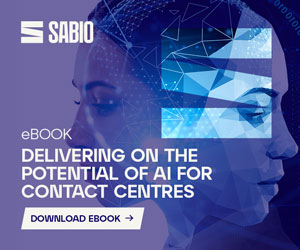Glenn Nethercutt at Genesys breaks down what agentic AI really is, how it differs from conventional automation, and why it’s set to redefine the future of customer experience.
Artificial intelligence (AI) has moved past the tipping point. What comes next will define the winners and expose the rest.
Forward-thinking companies are already making strategic investments in AI-powered solutions to streamline operations, accelerate growth and unlock tangible benefits.
According to customer experience (CX) leaders surveyed as part of the fourth edition of “The State of Customer Experience” report from Genesys, their organisations plan to set aside roughly 33% of their CX-related spend toward AI in the next year. Yet, amidst the excitement, a term is being stretched, rebranded and, in many cases, misused: agentic AI.
This powerful technology far surpasses traditional conversational intelligence and removes the limitations of today’s AI. Agentic AI is not an upgraded workflow engine wrapped in edgier branding. Nor is it a set of rigid and linear rules masquerading as intelligence.
True agentic AI represents a shift in how artificial intelligence functions. It moves beyond merely executing tasks and begins to reason, adapt and act autonomously within ethical and operational constraints that the organisation defines.
By 2028, “Gartner predicts that 33% of enterprise software applications will include agentic AI, up from less than 1% in 2024, with at least 15% of day-to-day work decisions being made autonomously through AI agents.”1
Despite its projected growth and vast potential, agentic AI applications in software today are still in their infancy. However, we’re seeing this term top the trend list for tech companies.
Just as “cloud computing” once became a catch-all term for any remotely hosted software, brands are now labelling even the simplest forms of AI-driven automation as agentic AI. This creates confusion and scepticism about a transformative solution that will drive real progress.
To fully realise the future of agentic AI, organisations must separate the hype from reality and prepare for the evolution ahead.
What Is Agentic AI – And What Isn’t It?
The first step in understanding agentic AI is to recognise what it is not.
Today, AI is commonly used to automate repetitive tasks, speed up workflows and generate content and insights. While these capabilities have their merits, they lack the ability to act with agency.
Most sophisticated AI systems are designed to execute based on pre-programmed logic rather than genuine reasoning.
These systems perform adequately in stable scenarios but fail when confronted with dynamic or ambiguous conditions.
Agentic AI operates outside these limitations. Unlike rule-based automation, which follows a predetermined set of instructions, agentic AI evaluates the broader context of a situation, considers multiple possibilities and determines the best course of action without relying on predefined workflows.
Instead of reacting passively to inputs, it proactively identifies problems and takes action independently to generate solutions.
From Transactions to Connections: Agentic AI-Powered CX
A practical example of this distinction can be seen across the customer experience: When a customer has an issue with an online order, they typically start with a chatbot that follows a rigid script.
The bot will ask for an order number, check the delivery status and escalate to human assistance if the issue isn’t resolved. While efficient, this static approach offers no room for adaptability beyond the bot’s pre-programmed replies.
Agentic AI transforms the customer experience from a simple transaction into a continuous engagement that draws intelligence and data to effortlessly align to a customers’ goals.
Continuing with the example of an online order, agentic AI detects delays in real time, cross-references inventory and shipping data, reviews the customer’s order history, and determines the best resolution, all without waiting for the customer’s input.
The agentic agent can issue a refund, reorder the item, offer a discount or send a proactive update explaining the next steps.
Agentic AI autonomously solves problems to orchestrate a seamless customer experience. With agentic AI, customers will benefit from faster, more intuitive interactions.
No more escalations. No more repeating yourself. Just fast, frictionless resolution powered by intelligence that acts the moment it’s needed.
So, what does this mean for your agentic AI strategy? Here are three key considerations:
1. From Raw Data to Real Impact: AI-Ready from Day One
AI is only as powerful as the data it consumes.
Many companies make the mistake of deploying generic AI models and expecting immediate results. But when AI lacks industry-specific or customer-centric data, it can produce impersonal and ineffective interactions that fail to drive business outcomes.
One of the key advantages of Cloud AI lies in its pre-built, contextualised data systems that eliminate the heavy lifting typically required for AI readiness.
Instead of spending years restructuring data across silos and platforms, organisations can rely on it to do the hard work for them. With Cloud AI, your data is already in the right shape to power intelligent, personalised experiences from Day One.
2. Providing Autonomy with Accountability
As AI becomes more autonomous, businesses must establish rules to ensure AI-driven decisions are reliable and aligned with customer trust.
Constitutional AI serves as the ethical backbone that keeps AI-driven systems aligned with legal, business and human standards.
Adopting a layered AI governance framework isn’t just a best practice, it’s a necessity for enabling compliance, trust and long-term AI sustainability.
3. Don’t Let AI Wander; Give It a Purpose
Too many companies invest in AI first and then search for a problem to solve.
A better approach is to start with a vision for how to make AI work smarter for your business. In CX, organisations should be focused on creating highly personalised, empathetic and efficient customer experiences.
Genesys believe every successful AI journey starts with a clear purpose. Early wins are essential for proving value and should always serve as building blocks for broader transformation.
Cloud AI is designed to support this progression, empowering organisations to move from tactical implementations to enterprise-wide orchestration.
Will Your Business Be Left Behind in the Agentic Era?
Agentic AI is no longer a visionary concept. It’s the battleground for today’s tech leaders.
Organisations that fail to strategically evolve risk falling behind as more agile competitors seize the advantage. To lead in this next era, organisations must act now before the advantage is gone.
Agentic AI will define the next generation of CX innovators. Will you shape the future, or chase it?
This blog post has been re-published by kind permission of Genesys – View the Original Article
For more information about Genesys - visit the Genesys Website
Call Centre Helper is not responsible for the content of these guest blog posts. The opinions expressed in this article are those of the author, and do not necessarily reflect those of Call Centre Helper.
Author: Genesys
Reviewed by: Jo Robinson
Published On: 25th Jul 2025
Read more about - Guest Blogs, Genesys




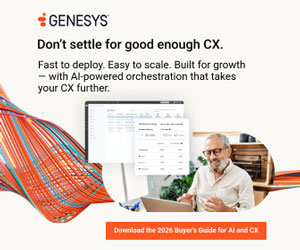

 Genesys empowers more than 8,000 organisations in over 100 countries to improve loyalty and business outcomes by creating the best experiences for their customers and employees. Through Genesys Cloud, the AI-Powered Experience Orchestration platform, Genesys delivers the future of CX to organisations of all sizes so they can provide empathetic, personalised experience at scale. As the trusted platform that is born in the cloud, Genesys Cloud helps organisations accelerate growth by enabling them to differentiate with the right customer experience at the right time, while driving stronger workforce engagement, efficiency and operational improvements.
Genesys empowers more than 8,000 organisations in over 100 countries to improve loyalty and business outcomes by creating the best experiences for their customers and employees. Through Genesys Cloud, the AI-Powered Experience Orchestration platform, Genesys delivers the future of CX to organisations of all sizes so they can provide empathetic, personalised experience at scale. As the trusted platform that is born in the cloud, Genesys Cloud helps organisations accelerate growth by enabling them to differentiate with the right customer experience at the right time, while driving stronger workforce engagement, efficiency and operational improvements. 




